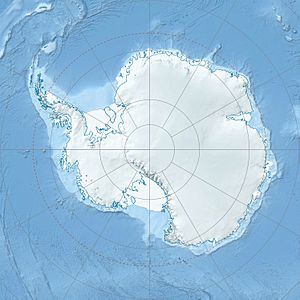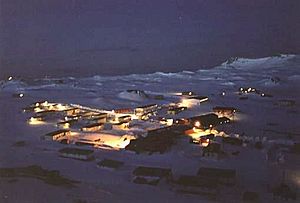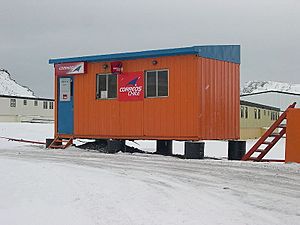Villa Las Estrellas facts for kids
Quick facts for kids
Villa Las Estrellas
|
|
|---|---|
|
Village
|
|
| Country | |
| Region | |
| Province | Antártica Chilena |
| Commune | Antártica |
| Location | King George Island |
| Inauguration | 9 April 1984 |
| Government | |
| • Type | Municipality |
| Elevation | 10 m (30 ft) |
| Population
(2017)
|
|
| • Summer | 150 |
| • Winter | 80 |
| Time zone | UTC−3 (CLST) |
| UN/LOCODE | AQ ESC |
| Activities | Meteorology |
Villa Las Estrellas is a small village in Antarctica. Its name means "The Stars Village" in Spanish. This village is located on King George Island.
Chile claims this area as part of its Chilean Antarctic Territory. However, Argentina and the United Kingdom also claim parts of Antarctica. Villa Las Estrellas is one of only two places in Antarctica where civilians live all year round. The other is Esperanza Base in Argentina.
The village is part of the President Eduardo Frei Montalva Base, which is a science station. In summer, about 150 people live here. In winter, the population drops to around 80.
Contents
Life in Villa Las Estrellas
The people living in Villa Las Estrellas have homes that are about 90 square meters (970 square feet) in size. A special event happened here in November 1984. Juan Pablo Camacho was born, becoming the first Chilean person born in Antarctica.
Learning and School Life
The F-50 "Villa Las Estrellas" School used to teach children from 1st to 8th grade. Two teachers worked there. Over 300 children learned at this school during its 33 years of operation until 2018. In 2014, there were 6 students. The village also has Library No. 291, where people can borrow books and magazines.
Healthcare and Safety
The village has a Chilean Air Force Hospital. It has one doctor and one nurse. The hospital can do X-rays, lab tests, and some surgeries. It also has a dental clinic. For serious emergencies, medical images can be sent to experts in other countries for help.
As of 2018, everyone who lives in Villa Las Estrellas, including children, needs to have their appendix removed before they move there. This is a safety rule because medical help is limited in Antarctica.
Businesses and Fun Activities
- Bank: A branch of Banco de Crédito e Inversiones operates all year. It has one banker.
- Chapel: The Santa María Reina de la Paz (St. Mary Queen of Peace) is a Catholic church. People from all over King George Island visit it.
- Hostel: From 1980 to 2019, there was a small hostel called Estrella Polar. It could host up to 20 guests.
- Souvenir Shop: There is a small shop that sells souvenirs. Tourists and staff buy gifts there. The women of the village run this shop.
- Sports Center: This is a very important place for the community. People play tennis, babyfútbol, basketball, and volleyball. It has exercise machines, ping pong tables, and a sauna. It's also used for cultural events, science talks, and even as a place to vote.
Staying Connected
- Telephones: People use satellite phones for the base. For villagers, there's a pay phone and prepaid cards.
- Internet: The school has computers with internet access.
- Radio: Radio Soberanía (Sovereignty) broadcasts music and news. It also shares cultural programs made by the staff and their families.
- Television: The village has a large satellite dish. This lets them watch live TV from Chile's main channels. They can also get two local TV stations.
- Mobile Phones: Since 2005, there has been a mobile phone antenna from the Chilean company Entel PCS.
Getting to Villa Las Estrellas
The closest airport is the Teniente R. Marsh Airport. This is the only airport in Antarctica that has an IATA code. There are no regular flights for the public. However, Aerovías DAP offers some special charter flights from Punta Arenas in Chile.
Antarctic Climate
Villa Las Estrellas has a polar climate. This means winters are cold, but often milder than other very cold places like parts of Alaska or Siberia. Summers are short and cool.
During winter, it stays just above freezing. This makes the weather very harsh for people. There is also very little sunshine. This can lead to low vitamin D levels or even depression. The average yearly temperature is about -2.3 degrees Celsius (27.9 degrees Fahrenheit). This is still quite mild for Antarctica.
| Month | Jan | Feb | Mar | Apr | May | Jun | Jul | Aug | Sep | Oct | Nov | Dec | Year |
|---|---|---|---|---|---|---|---|---|---|---|---|---|---|
| Record high °C (°F) | 13.0 (55.4) |
9.2 (48.6) |
8.3 (46.9) |
5.9 (42.6) |
4.6 (40.3) |
4.2 (39.6) |
5.0 (41.0) |
3.8 (38.8) |
4.4 (39.9) |
4.4 (39.9) |
6.0 (42.8) |
8.2 (46.8) |
13.0 (55.4) |
| Mean daily maximum °C (°F) | 2.7 (36.9) |
2.9 (37.2) |
2.2 (36.0) |
0.6 (33.1) |
−0.8 (30.6) |
−1.5 (29.3) |
−0.9 (30.4) |
−2.2 (28.0) |
−1.3 (29.7) |
−0.8 (30.6) |
0.0 (32.0) |
2.1 (35.8) |
0.3 (32.5) |
| Daily mean °C (°F) | 1.5 (34.7) |
1.6 (34.9) |
0.4 (32.7) |
−1.7 (28.9) |
−3.8 (25.2) |
−5.5 (22.1) |
−6.5 (20.3) |
−6.5 (20.3) |
−4.5 (23.9) |
−2.6 (27.3) |
−1.0 (30.2) |
0.6 (33.1) |
−2.3 (27.9) |
| Mean daily minimum °C (°F) | 0.3 (32.5) |
0.6 (33.1) |
−1.2 (29.8) |
−4.8 (23.4) |
−8.2 (17.2) |
−9.4 (15.1) |
−13.2 (8.2) |
−11.3 (11.7) |
−8.0 (17.6) |
−5.6 (21.9) |
−2.8 (27.0) |
−0.3 (31.5) |
−5.3 (22.5) |
| Record low °C (°F) | −5.1 (22.8) |
−5.8 (21.6) |
−9.9 (14.2) |
−16.8 (1.8) |
−23.6 (−10.5) |
−24.2 (−11.6) |
−28.5 (−19.3) |
−28.7 (−19.7) |
−23.0 (−9.4) |
−17.0 (1.4) |
−10.7 (12.7) |
−6.8 (19.8) |
−28.7 (−19.7) |
| Average precipitation mm (inches) | 53.8 (2.12) |
52.3 (2.06) |
52.5 (2.07) |
46.6 (1.83) |
31.0 (1.22) |
29.2 (1.15) |
32.2 (1.27) |
34.5 (1.36) |
42.0 (1.65) |
47.7 (1.88) |
41.0 (1.61) |
30.1 (1.19) |
492.9 (19.41) |
| Average relative humidity (%) | 91 | 89 | 89 | 89 | 88 | 90 | 89 | 88 | 89 | 90 | 89 | 81 | 89 |
| Mean monthly sunshine hours | 83.8 | 71.2 | 57.3 | 23.6 | 8.3 | 1.2 | 3.9 | 15.8 | 44.2 | 93.2 | 104.5 | 98.1 | 605.1 |
| Source: Dirección Meteorológica de Chile (temperature data:1970-2004, all other 1990-2000) | |||||||||||||
See also
 In Spanish: Villa Las Estrellas para niños
In Spanish: Villa Las Estrellas para niños







